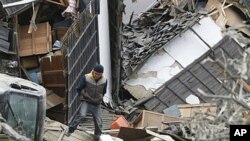Officials say a powerful aftershock that rattled Japan late Thursday night killed at least two people and injured around 100.
The 7.1-magnitude quake knocked out several power plants and triggered a tsunami alert that was later lifted.
The Tokyo Electric Power Company says there is no sign the earthquake caused new problems at the damaged Fukushima nuclear plant. Workers at the station took shelter immediately after the aftershock, which hit just after 11:30 p.m.
An official from Japan's Nuclear Industrial and Safety Agency says emergency nitrogen and water injections into the dangerously overheated nuclear reactors at Fukushima continued remotely while the workers evacuated.
Workers at the plant have been struggling for three weeks to bring the radiation-leaking nuclear power plant under control after its cooling systems were knocked out on March 11.
Power lines to three other nuclear plants were affected by the earthquake, but officials say at least one emergency source of power remained operational at all those plants.
The U.S. Geological Survey said Thursday's aftershock registered a magnitude of 7.1 with an epicenter 40 kilometers under the seabed. Earlier estimates had described the tremor as 7.4 magnitude. A VOA reporter in the capital said the tremor had been "strongly felt" in Tokyo.
There were widespread power outages across the northeast. An official with Japan's meteorological agency warned there may be additional "intense" aftershocks, and said there was a high risk of houses collapsing and mudslides.
Japan is still reeling from a massive 9.0 earthquake and massive tsunami that devastated large areas of the northeast on March 11.
Japanese officials earlier Thursday had said that efforts to pump nitrogen into the containment vessel of the Fukushima damaged nuclear reactor appeared to be succeeding, easing fears that a hydrogen build-up in the vessel could cause a dangerous explosion. They said the operation could last for several days and may be repeated at the number two and number three reactors.
Technicians with the Tokyo Electric Power Company also are pumping the last of 11,500 tons of contaminated water into the ocean in order to make room in a storage area for water from the basements of the damaged reactors that is 200,000 times more radioactive.
The nuclear accident, caused when the March 11 earthquake and tsunami knocked out cooling systems at the plant's six reactors, is considered the second worst in history.
Public anxiety over the nuclear situation has been high in several countries, with reports of panic purchases of iodine tablets in the western United States and of salt in China and South Korea. In South Korea Thursday, some schools were closed because of fears that a passing rainfall may be radioactive.
Some information for this report was provided by AP and AFP.













